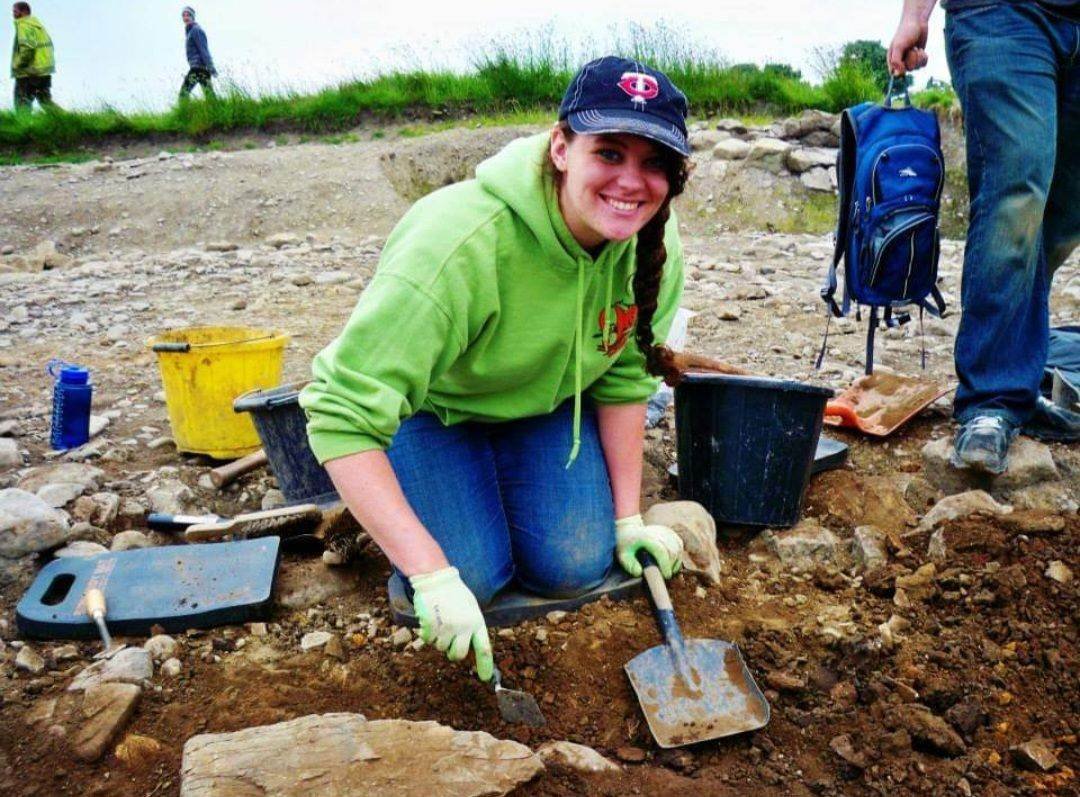History 21 The Podcast - 3.11 Secret Archeologists at ACHS
In this episode, learn about the secret lives of those closest to ACHS! Don Johnson (ACHS Staff) and Allison Schmitt (ACHS Board Member) chat about their experiences in archaeology and geophysics while also dispelling the myth of being a real-life Indiana Jones. They share how their academic skills transfer to the museum, proving that indeed, no education is ever wasted.
Host Sara Given, ACHS Volunteer Coordinator, and Rebecca Desens, ACHS Executive Director.
In a previous life…
Allison Schmitt
Allison has a job in real life she can’t spill too many beans on, so we traveled back in time to her experiences digging at Hadrian’s Wall in Scotland. If you look closely, you can see the iron orange of some nails in the soil.
Don Johnson
Ever wonder how you transport loads of expensive equipment unscathed through the wilds of nature to a work site? Don recommends Samsonite luggage. It’s sturdy and rather touristy looking and gets you passed customs with fewer questions! Hear the full story by subscribing to our Vault content for $5 monthly.
Full Interview on the Vault
Anoka County Library Minute
Further Reading:
Lives in Ruins: archaeologists and the seductive lure of human rubble by Marilyn Johnson (930.1 JOH)
While many may think of Indiana Jones when they first hear archaeology and associate the profession with historical thrill seekers, the author of this book attempts to paint a more honest depiction of the profession. While pointing to the very real downsides, Johnson also makes the case that archaeology is an essential profession in keeping humanity’s story alive and not forgotten.
Finders Keepers: a tale of archaeological plunder and obsession by Craig Childs (930.1 CHI)
A thorough examination of the ethics involved in archaeology and museum curation. This book asks the question, “to whom should the past belong?” and “how can we be good stewards to the past?” The author looks at these moral issues from multiple angles and acknowledges the murkiness of these questions.
This National Geographic illustrated guide to the top archaeological discoveries to date offers short, chronological summaries. It also features an introduction written by fiction and nonfiction author Douglas Preston, who writes about archaeology for the New Yorker Magazine.
The Lost City of the Monkey God: a true story by Douglas Preston (972.83 PRE)
This is the nail-biting true account of the author’s accompaniment on a scientist-led expedition into the Honduran rainforest. The team, armed with state-of-the-art technology, was in search of a legendary lost civilization that promised both tremendous wealth and deadly illness.
Cries From the Lost Island by Kathleen O’Neal Gear (FANTASY GEA)
A young, budding historical scholar’s friend, who believes she is the reincarnated Queen Cleopatra, is found murdered. The protagonist, Hal, and his only other friend, Roberto, set off to Egypt to fulfill her last request: to search for the lost graves of Marc Antony and Cleopatra. The author expertly blends modern-day life with ancient Egyptian imagery.
Crocodile on the Sandbank by Elizabeth Peters (MYSTERY PET)
The author of this series earned a doctorate in Egyptology and infuses her stories with archaeological detail. This book is the first in Peters’ Amelia Peabody series, in which the Victorian feminist heroine utilizes a family inheritance to travel the world. While doing so, she meets new friends and encounters mysteries and endeavors to solve them.
Treasure by Philip Steele (QJ930.1 STE)
This book from DK Eyewitness, gives younger readers a look at precious objects found throughout history and describes how they were discovered. Colorful illustrations accompany each entry.
Motel of the Mysteries by David Macaulay (ebook)
Available as an ebook through the library’s Libby app, this book is a satirical look at archaeology and modern American culture. In the year 4022, “Usa” is a country that has long-since been destroyed. But when an archaeologist discovers some ruins, everyday mundane items from the time are hilariously interpreted to have had significant, even sacred meanings.




